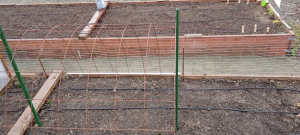Sanitation in a garden means essentially the same thing it means in a home or a hospital: removing things that can lead to infections — or in this case, infestations.
“Things that can lead to infestations” are simply locations or conditions where insects, fungi, and bacteria can shelter, feed and reproduce.
A lesson from the Covid pandemic is very applicable to a community garden: preventing infestations isn’t just about your own condition. Diseases are very opportunistic and if allowed will spread out as fast and as far as they can. As we’ve seen far too often, one badly neglected garden bed can cause crop failures in a number of neighboring beds.
Yes, it's just like spreading Covid.
Dead or unhealthy-looking leaves and branches are pretty obvious since most of the time they’re already providing a favorable living place for one or more pathogens. But even if their condition was caused by injury or lack of nutrition, their weakened state makes them less able to resist becoming infested — much like humans with "pre-existing conditions."
- Affected plant material should be removed from the garden area. Infected branches should be cut back to a non-infected junction using sharpened pruning shears.
- All tools used to treat diseased plants should be sanitized during and after the process (just like surgeon's tools) by dipping them in a container of alcohol or other sanitizer.
- When removing diseased plant material take care not to spread the spores by careless handling.
- Spores of powdery mildew, for example, are microscopic and are designed to be spread by wind currents — including those created when foliage is cut and removed from a garden bed.
- Removed plant material should be disposed of away from the garden area; preferably at your home.
- Diseased material shouldn’t be composted since compost piles don’t generate enough heat to kill off disease or fungus spores.
Fruit that has fallen off the plant provides an excellent shelter and source of nutrition for pests. As it's certainly not doing the garden any good, it should be removed immediately.
Plants that have finished producing food have usually been in the garden long enough to have begun hosting pests, especially if their vigor — and therefore, resistance -- have begun to decline.
- When removing completed crops it's generally best to remove the entire plant, roots and all.
- The exception would be for legumes -- peas and beans -- whose roots contain nitrogen-rich nodules that can continue to provide nourishment for new crops.
One of the best opportunities to rid the garden of pests is in the Fall.
- All pests need a place to survive the winter’s cold weather.
- Destroy their shelters and food supply and there will be far fewer to control at the beginning of the next season.
- Ideal places for pests to survive the winter period are
- trash,
- vegetable stubble,
- unharvested fruits and roots, and
- overgrown grass and weeds along the edge of a garden bed and along the fence.
- Deep spading or rototilling the soil will expose many insects to be eaten by birds and other predators.
- Best results are obtained if the soil is tilled at least twice during the winter months.


Even gardeners who maintain cold-hardy crops throughout the winter should take all possible measures to ensure their garden beds are free of any places for pests to over-winter. They should remove and destroy all over-wintered plant material as soon as the plants have finished producing harvestable crops.
“Sanitation is the key to successful gardening,” adding “a little work in the fall can prevent a lot of trouble next spring.”
